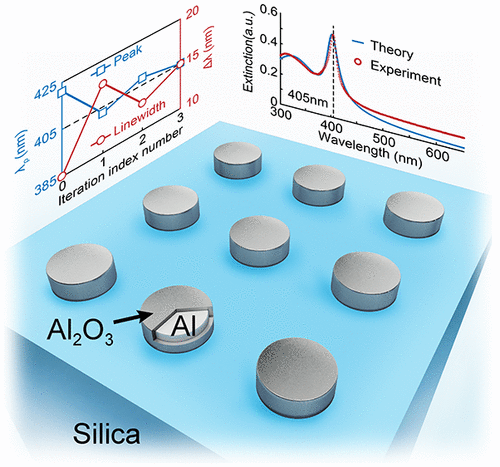当前位置:
X-MOL 学术
›
ACS Photonics
›
论文详情
Our official English website, www.x-mol.net, welcomes your feedback! (Note: you will need to create a separate account there.)
Beyond Noble Metals: High Q-Factor Aluminum Nanoplasmonics
ACS Photonics ( IF 7 ) Pub Date : 2020-01-27 , DOI: 10.1021/acsphotonics.9b01368 Xiangchao Zhu 1 , Golam Md. Imran Hossain 1 , Matthew George 2 , Arash Farhang 2 , Ahmet Cicek 3 , Ahmet Ali Yanik 1, 4
ACS Photonics ( IF 7 ) Pub Date : 2020-01-27 , DOI: 10.1021/acsphotonics.9b01368 Xiangchao Zhu 1 , Golam Md. Imran Hossain 1 , Matthew George 2 , Arash Farhang 2 , Ahmet Cicek 3 , Ahmet Ali Yanik 1, 4
Affiliation

|
Aluminum, with its distinctively favorable dielectric characteristics down to deep ultraviolet (UV) regime, has recently emerged as a broad-band and low-cost alternative to noble metals. However, low Q-factor resonances (Q ∼ 2–4), offered by Al nanostructures, pose a fundamental bottleneck for many practical applications. Here, we show that it is possible to realize Al-nanoantenna with remarkably large extinction cross sections and strong resonance characteristics surpassing those of their noble metal counterparts. By quenching radiation damping through far-field coherent dipolar interactions, we experimentally demonstrate exceptionally narrow line width (∼15 nm) and high Q-factor (∼27) dipolar plasmonic resonances in the blue-violet region of the optical spectrum (∼3 eV) beyond the practical operational limits of traditional plasmonic metals. To realize high Q-factor Al resonators, we introduce a novel space mapping algorithm enabling inverse design of Al nanoantenna arrays at arbitrary sub/superstrate material interfaces with diminished radiative losses. We show that radiatively coupled Al nanoantenna arrays offer remarkably high-Q factor (27 ≤ Q ≤ 53) resonances over the entire visible spectrum and readily outperform similarly optimized silver (Ag) nanoantenna arrays in green-blue-violet wavelengths (≤550 nm) and near UV regime. This report shows that it is possible to realize high Q-factor aluminum resonators by suppressing radiative losses and that Al-based plasmonics holds enormous potential as a viable and low-cost alternative to noble metals. Our inverse-design technique, on the other hand, provides a general and efficient approach in engineering of high Q-factor resonator arrays, independently from the metals and sub/superstrates used.
中文翻译:

超越贵金属:高Q因子铝纳米等离子体
铝具有低至深紫外线(UV)的独特有利的介电特性,最近已成为贵金属的宽带和低成本替代品。然而,低Q -因子共振(Q〜2-4),由铝纳米结构提供,构成了许多实际应用的根本瓶颈。在这里,我们表明可以实现具有显着大的消光截面和强于其贵金属对应物的共振特性的铝纳米天线。通过通过远场相干偶极相互作用消除辐射阻尼,我们实验证明了极窄的线宽(约15 nm)和高Q光谱的蓝紫色区域(〜3 eV)中的-因子(〜27)偶极等离子体共振超出了传统等离子体金属的实际操作极限。为了实现高Q因子Al谐振器,我们引入了一种新颖的空间映射算法,可以在任意子/上层材料界面处反向设计Al纳米天线阵列,并减少辐射损耗。我们表明,辐射地耦合的Al纳米天线阵列提供显着高Q因数(27≤ Q在整个可见光谱≤53)的共振和容易跑赢类似地优化银(Ag)在绿-蓝-紫色波长纳米天线阵列(≤550纳米)并接近紫外线。该报告表明有可能实现高Q铝制谐振器可抑制辐射损耗,而铝基等离子体激元作为贵金属的可行且低成本替代品具有巨大潜力。另一方面,我们的逆设计技术为高Q因子谐振器阵列的工程设计提供了一种通用且有效的方法,而与所使用的金属和子/上基板无关。
更新日期:2020-01-29
中文翻译:

超越贵金属:高Q因子铝纳米等离子体
铝具有低至深紫外线(UV)的独特有利的介电特性,最近已成为贵金属的宽带和低成本替代品。然而,低Q -因子共振(Q〜2-4),由铝纳米结构提供,构成了许多实际应用的根本瓶颈。在这里,我们表明可以实现具有显着大的消光截面和强于其贵金属对应物的共振特性的铝纳米天线。通过通过远场相干偶极相互作用消除辐射阻尼,我们实验证明了极窄的线宽(约15 nm)和高Q光谱的蓝紫色区域(〜3 eV)中的-因子(〜27)偶极等离子体共振超出了传统等离子体金属的实际操作极限。为了实现高Q因子Al谐振器,我们引入了一种新颖的空间映射算法,可以在任意子/上层材料界面处反向设计Al纳米天线阵列,并减少辐射损耗。我们表明,辐射地耦合的Al纳米天线阵列提供显着高Q因数(27≤ Q在整个可见光谱≤53)的共振和容易跑赢类似地优化银(Ag)在绿-蓝-紫色波长纳米天线阵列(≤550纳米)并接近紫外线。该报告表明有可能实现高Q铝制谐振器可抑制辐射损耗,而铝基等离子体激元作为贵金属的可行且低成本替代品具有巨大潜力。另一方面,我们的逆设计技术为高Q因子谐振器阵列的工程设计提供了一种通用且有效的方法,而与所使用的金属和子/上基板无关。


























 京公网安备 11010802027423号
京公网安备 11010802027423号